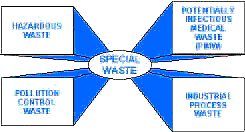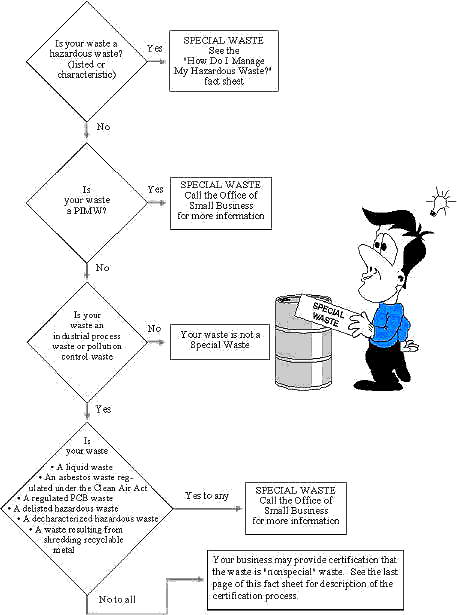Do I Have a Special Waste?
Information presented in this publication is intended to provide a general understanding of the statutory and regulatory requirements governing special waste. This information is not intended to replace, limit or expand upon the complete statutory and regulatory requirements found in the Illinois Environmental Protection Act and Title 35 of the Illinois Administrative Code of Regulations.
Illinois regulates many different types of waste, including special waste. Because you generate waste, it is your responsibility to figure out what type of waste you generate. This can be a confusing process! This fact sheet will help you understand what special waste is and help you determine whether you generate a special waste. Special waste needs to be managed and disposed of properly to protect our environment. To understand what kind of special wastes you may generate, ask yourself the following questions in the order presented below, then follow the flowchart below to figure out if you generate a special waste.
- 1. What is a Special Waste?
- 2. What is a Hazardous Waste?
- 3. What is a PIMW?
- 4. What is an Industrial Process Waste?
- 5. Where Can I Find Information?
- 6. What is a Pollution Control Waste?
- 7. What is Used Oil?
- 8. What is a Liquid Waste?
- 9. What is an Asbestos Waste Regulated Under the Clean Air Act?
- 10. What is a Regulated PCB Waste?
- 11. Tip
- 12. What is a Delisted Hazardous Waste?
- 13. What is a Decharacterized Hazardous Waste?
- 14. What is an Example of a Waste Generated by Shredding Recyclable Metals?
- 15. Are There Industrial Process Wastes and Pollution Control Wastes that are not Special Waste?
- 16. Special Waste Determination Process
- 17. Nonspecial Waste Certification
- 18. Examples of Nonspecial Waste Certifications
Special waste includes hazardous waste, potentially infectious medical waste (PIMW), industrial process waste, and pollution control waste.
A hazardous waste is (1) listed on the Illinois Environmental Protection Agency hazardous waste list or (2) has the characteristic of ignitability, corrosivity, reactivity, or toxicity (determined by generator knowledge or analytical testing in a laboratory).

Generator knowledge and analytical testing of the waste are used to determine if your waste is a hazardous waste. Generator knowledge means the business that generates the waste has sufficient information to determine if the waste is hazardous based on its understanding of the waste generating process and the raw materials used in the process. Analytical testing of a sample of your waste is done by a laboratory.
PIMW is generated in connection with the diagnosis, treatment, or immunization of human beings or animals; medical research; and biological testing. The businesses that typically generate PIMW are hospitals, nursing homes, medical or veterinary clinics, dental offices, clinical or pharmaceutical laboratories, university or research facilities, and other such facilities.
An industrial process waste is any liquid, solid, semisolid, or gaseous waste generated when manufacturing a product or performing a service. Examples include cutting oils, paint sludges, equipment cleanings, metallic dust sweepings, used solvents from parts cleaners, and off-specification, contaminated, or recalled wholesale or retail products. The following wastes are not industrial process wastes:
- Uncontaminated packaging materials
- Uncontaminated machinery components
- General household waste
- Landscape waste
- Construction or demolition debris
A material safety data sheet (MSDS) is a document available for most commercial products and chemicals that presents information on the materials such as hazard classification and proper disposal.
A pollution control waste is generated directly or indirectly when businesses remove contaminants from air, soil, or water. Examples include baghouse dust, landfill waste, scrubber sludge, and chemical spill cleaning material.
If your industrial process waste or pollution control waste is any one of the following, it is a special waste:
- A liquid waste
- An asbestos waste regulated under the Clean Air Act
- A regulated polychlorinated biphenyl (PCB) waste
- A delisted hazardous waste
- A characteristic hazardous waste treated or stabilized to be nonhazardous
- A waste material generated by shredding recyclable metals
The following questions will help you understand each of these industrial process or pollution control wastes.
Because used oil is often recycled or reused, used oil has its own management requirements. For more information on how to manage your used oil, see the used oil fact sheet.
Liquid waste is any waste material that is determined to contain "free liquids." Used cutting oil is a typical liquid waste. For sludges or other wastes that you cannot easily determine is liquid, you can use the paint filter test. The test requires pouring the waste through a specific filter to determine if the waste contains "free liquids."
Asbestos waste regulated under the Clean Air Act is (1) any waste that contains commercial asbestos and (2) any asbestos waste generated during demolition or renovation. Examples include insulation, fireproofing materials, and packaging contaminated with commercial asbestos.
PCBs are typically found in old transformers and other electrical equipment. A PCB waste is a waste that contains any monochlorinated or polychlorinated biphenyl or any mixture that contains one or more of them. This includes equipment, solids (including empty containers) and contaminated liquids.
To protect the environment and reduce your regulatory requirements, minimize the amount of waste you generate.
A delisted hazardous waste is excluded from the list of hazardous wastes when the Illinois Pollution Control Board grants a petition filed by a business.
A decharacterized hazardous waste is a hazardous waste that has been treated to make it nonhazardous or the hazardous characteristic, ignitability, corrosivity, reactivity, or toxicity, has been removed.
When autos and trucks are shredded to reclaim metals, a significant amount of other materials are generated such as upholstery and plastics (auto fluff). This material is often contaminated during the recycling process and must be managed as a special waste.
Yes, in some instances you may certify that your waste is not a special waste by following the procedures on page 4.
This flow chart can assist you in determining if you generate a special waste.

Any industrial process wastes and pollution control wastes that are not hazardous and not liquid may be certified as nonspecial waste in Illinois and may be disposed of with your general refuse. In addition to these wastes, the containers that once held them may also be excluded from the definition of special waste if:
- The container no longer contains a liquid
- All wastes have been removed
- Any residue is less than 1 inch thick
- Any inner liner has been removed and disposed of as special waste
If you determine that the industrial process or pollution control waste that you generate is a " nonspecial waste", you may prepare a nonspecial waste certification. This certification must be made in writing and must be provided when requested by Illinois EPA, the waste transporter, the disposal site, and any one else involved in managing the waste. If you do not make this written certification, the waste is still considered a special waste and must be managed as a special waste.
The information contained in this certification must include (as applicable):
- A description of the process that generated the waste
- How you determined the waste is not hazardous
- How you determined the waste is not a liquid, does not contain PCBs, asbestos, is not formerly hazardous waste rendered nonhazardous, and is not redded recyclable metals
- Any analytical results, or relevant MSDS
- An explanation as to why any analysis was not performed or required
If the process that generates the waste changes or the raw materials change, you must complete a new certification. Certifications must be signed, dated, and kept for at least 3 years after you stop operating the process that generates the certified nonspecial waste. The law provides stiff penalties for false certification.
No specific form is required for nonspecial waste certifications. Some example certifications are provided below.
John's Auto Body
123 Main Street
Roscoe, IL 61073
9-29-97
I certify that masking materials used when spray painting vehicles in my shop, including paper, plastic, and masking tape with paint overspray are not hazardous, not liquid, do not contain PCBs or asbestos, are not formerly hazardous , are not shredded recyclable metals, and are not special wastes. I determined that my wastes are not special wastes by looking at my MSDS. I also certify that discarded paint cans are empty and no longer contain any liquids. MSDS for paints are attached.
John R. Karr
[signature]
Owner
Mike's Machine Shop
2616 N.E. Adams St.
Peoria, IL 61611
6 Nov. 1997
I certify that grit from grinding and metal grindings, shavings, turnings, and scrap resulting from machining various components are nonhazardous and nonliquid; do not contain asbestos or PCBs; are not formerly hazardous waste rendered nonhazardous; are not generated by shredding recyclable metals. Therefore, these are not special waste.
Michael W. Thomas
[signature]
Owner/Manager
(Analytical results attached)

